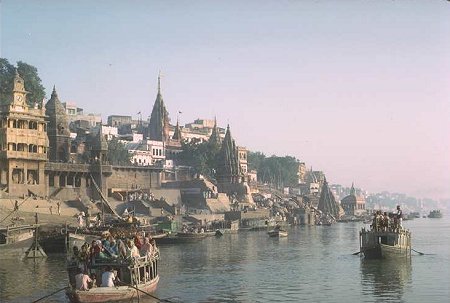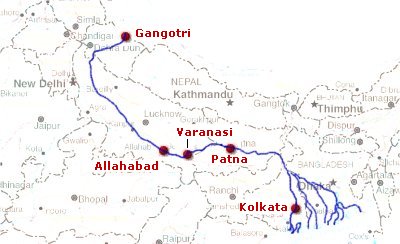The River Ganga (Ganges)
by Vikas Kamat
First Online: June 03, 2005
Page Last Updated: December 07, 2024
The Ganga river, also known as the Ganges is a major river (length: about 1500 miles) of the Indian subcontinent, formed in the southern ranges of the Himalayas, in the state of Uttaranchal. The Ganges river basin (a.k.a. Gangetic plains) is one of the most fertile regions of the world and also one of the most densely populated, lies between the Himalayas and the Vindhya ranges embracing an area of more than 1 million sq. kms.
Accumulated rains along its banks (during the monsoons) and melted snow from the Himalayas (during summers) keep the river always adequately vigorous.
Illustrious Flow through Indian Heartland
The river emerges from an ice cave, 10,300 ft above sea level as Bhairathi river. About about 10 miles from the source is Gangotri, the first temple on its banks and a traditional resort of pilgrims. At the village of Devaprayag, some120 miles downstream, the Bhagirathi joins the Alaknanda river to form the Ganges. The river then flows west to Haridwar, then to southeast to Allahabad gaining tremendous momentum.
Corel Professional Photo/Kamat's Potpourri
Ganges River in Varanasi
At Allahabad, the Ganges is joined by the Yamuna river. from the southwest, and from that point the river flows east past Mirzapur, Varanasi, Ghazipur, Patna, Monghyr, and Bhagalpur, receiving Son, Gomati, Ghaghara, Gandak, and Kosi rivers. In the Rajmahal Hills, at the head of the Ganges delta, 563 miles from Allahabad, the river turns south yet again and begins a descent of 283 miles to the Bay of Bengal. Near Pakaur, the Bhagirathi (again assuming the former name of the river) and, 71 miles lower down, the Jalangi river branch off from the main stream, and after individual courses of 120 miles each, unite to form the Hoogli river. The main branch of the Ganges, from which numerous minor tributaries flow, continues in Bangladesh, as the Padma river., to the town of Shivalaya (a.k.a. Sibalay), where it unites with the Jamuna, the main branch of the Brahmaputra, and finally runs through the Meghna estuary into the Bay of Bengal.
K.L. Kamat/Kamat's Potpourri
The Course of River Ganga
Between the Meghna estuary and the west channel of the Hoogli river are the several mouths of the deltaic channels. The northern portion of the delta is fertile and well cultivated. The southern section consists mostly of swampland, known as the Sundarbans, rich in vegetation and animal life. The marshes in Sundarbans are infested by several species of crocodiles, and the forests are the last home to Bengal Tigers. From year to year the Ganges exchanges old channels for new ones, particularly in the alluvial basin of its lower reaches.
Role in Mythology, Folklore, and Culture
Ganga river features prominently in Indian classics and folklore -- from Vedas to Bollywood. The descent of Ganga from heaven to earth has been glorified in great works of Indian art and literature. Many popular movies in India revolve around the mystique of the river, so are popular songs. "I live where Ganga flows" (Jis desh mein Ganga behti hai) is a particular favorite.
The Ganges is regarded by Hindus as the most sacred river in the world. It is said that Lord Vishnu (Hari) himself bathed in Ganga (hence the name Haridwar) to purify himself. Ganga is revered as daughter of Meru, as the mother of Bhishma, and Jahnavi (emerging from the thighs of sage Jahnu).
Many important religious ceremonies are held in cities on its banks, including Varanasi, Haridwar, and Allahabad. The water of Ganga (called Gangajal) is stored in most Indian homes as "sacred water" and fed to those on death-bed as the "last meal" on earth. Gangajal is also the base for many traditional medicines of India.
Ganga as the "River of India"
Jawaharlal Nehru, the great Indian leader has described Ganga as "The River of India".

The Ganga, especially, is the river of India, beloved of her people, round which are intertwined her memories, her hopes and fears, her songs of triumph, her victories and her defeats. She has been a symbol of India's age-long culture and civilization, ever changing, ever flowing, and yet ever the same Ganga.

Despite of the enormous pollution the river has absorbed in the last few decades, Ganga river continues to attract millions for the intense experience she provides -- be it a photographic opportunities or the opportunity to cleanse one's sins.
![]()
References
- World Almanac, OCLC, 2005
- Microsoft Encarta, 2005

